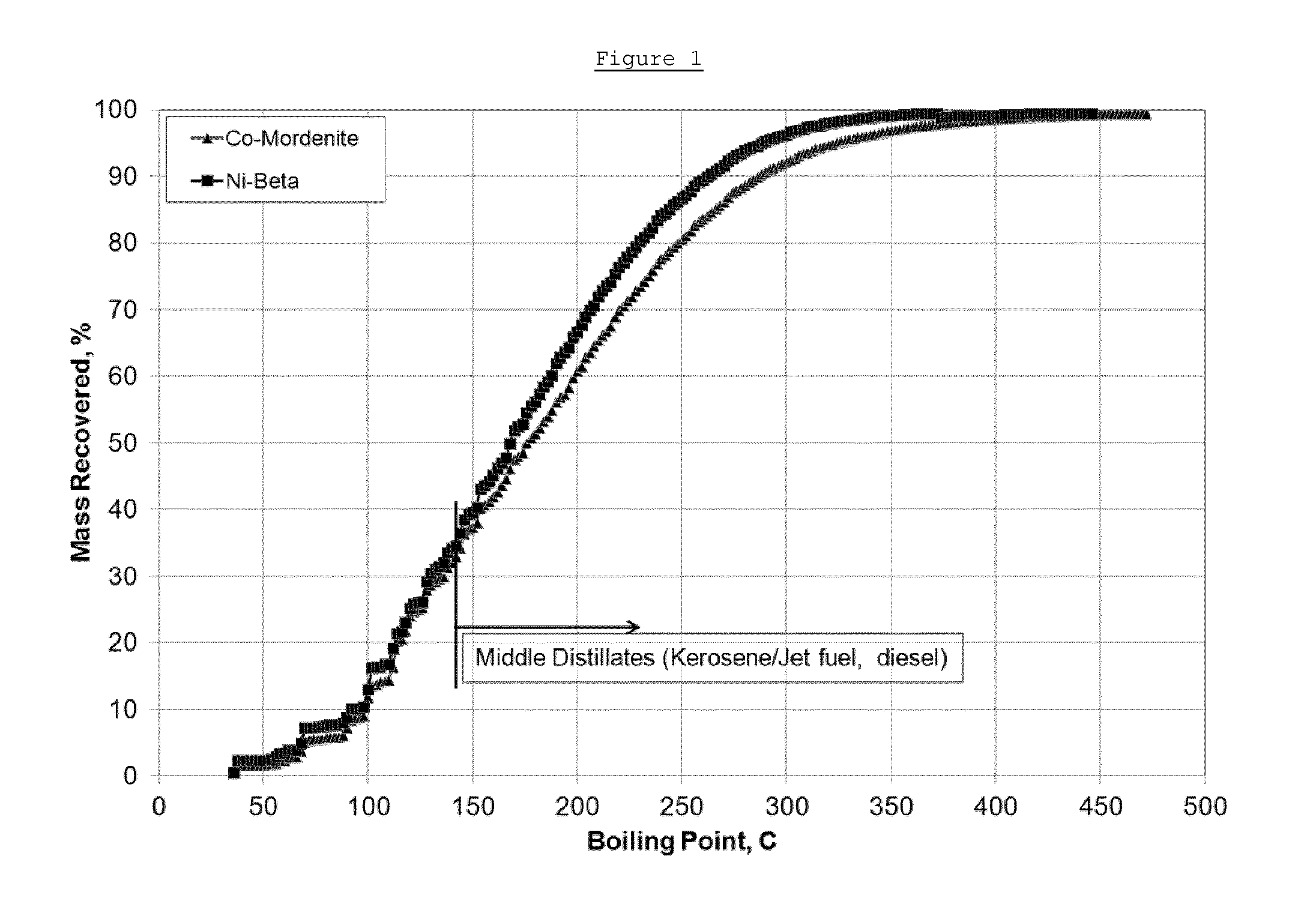Catalyst and method for preparation thereof
a catalyst and catalyst technology, applied in the field of new catalysts, can solve the problems of limited viability of converting oxygenates into hydrocarbons, excessive coking and subsequent deactivation of catalysts, and the deactivation of prior art catalysts may become an issue, and achieve the effect of not having a substantial deactivation of catalysts
- Summary
- Abstract
- Description
- Claims
- Application Information
AI Technical Summary
Benefits of technology
Problems solved by technology
Method used
Image
Examples
examples 1a and 1b
Conversion of a Mixed Ketone Feed in a Stacked Bed Containing a Nickel-Exchanged Mordenite Zeolite Catalyst (Carbon-Carbon Coupling Catalyst A) and a Hydrotreatment Catalyst
[0055]A powder of mordenite zeolite with an ammonium form and an SiO2:Al2O3 molar ratio (SAR) of approximately 20 was obtained commercially from Zeolyst International. An aqueous solution of 1 mol / liter nickel (II) nitrate hexahydrate was prepared and the pH of the solution was adjusted to 6 using ammonium hydroxide. The powder of mordenite zeolite was suspended in nickel nitrate solution in an amount of about 10 ml of nickel nitrate solution to about 1 gram of mordenite powder and the slurry was vigorously agitated using a stirrer or impeller to get a uniform suspension. Subsequently the temperature of the slurry was raised to 95° C. while refluxing and then maintained at 95° C. for 1 hour. The slurry was vigorously agitated using a stirrer or impeller during the whole of the ion-exchange step. Hereafter the slu...
examples 2a and 2b
Conversion of a Mixed Ketone Feed in a Stacked Bed Containing a Cobalt-Exchanged Mordenite Zeolite Catalyst (Carbon-Carbon Coupling Catalyst B) and a Hydrotreatment Catalyst
[0061]A powder of mordenite zeolite with an ammonium form and an SiO2:Al2O3 molar ratio (SAR) of approximately 20 was obtained commercially from Zeolyst International. An aqueous solution of 1 mol / liter cobalt (II) nitrate hexahydrate was prepared and the pH of the solution was adjusted to 6 using ammonium hydroxide. The powder of mordenite zeolite was suspended in cobalt nitrate solution in an amount of about 10 ml of cobalt nitrate solution to about 1 gram of mordenite powder and the slurry was vigorously agitated using a stirrer or impeller to get a uniform suspension. Subsequently the temperature of the slurry was raised to 95° C. while refluxing and then maintained at 95° C. for 1 hour. The slurry was vigorously agitated using a stirrer or impeller during the whole of the ion-exchange step. Hereafter the slu...
examples 3a and 3b
Conversion of a Mixed Ketone Feed in a Stacked Bed Containing a Nickel-Exchanged Zeolite Beta Catalyst (Carbon-Carbon Coupling Catalyst C) and a Hydrotreatment Catalyst
[0069]A powder of zeolite Beta with an ammonium form and an SiO2:Al2O3 molar ratio (SAR) of approximately 20 was obtained commercially from Zeolyst International. An aqueous solution of 1 mol / liter nickel (II) nitrate hexahydrate was prepared and the pH of the solution was adjusted to 6 using ammonium hydroxide. The zeolite Beta powder was suspended in the nickel nitrate solution in an amount of about 10 ml of nickel nitrate solution to about 1 gram of zeolite Beta powder and the slurry was vigorously agitated using a stirrer or impeller to get a uniform suspension. Subsequently the temperature of the slurry was raised to 95° C. while refluxing and then maintained at 95° C. for 1 hour. The slurry was vigorously agitated using a stirrer or impeller during the whole of the ion-exchange step. Hereafter the slurry was coo...
PUM
| Property | Measurement | Unit |
|---|---|---|
| molar Ratio | aaaaa | aaaaa |
| molar Ratio | aaaaa | aaaaa |
| molar Ratio | aaaaa | aaaaa |
Abstract
Description
Claims
Application Information
 Login to View More
Login to View More - R&D
- Intellectual Property
- Life Sciences
- Materials
- Tech Scout
- Unparalleled Data Quality
- Higher Quality Content
- 60% Fewer Hallucinations
Browse by: Latest US Patents, China's latest patents, Technical Efficacy Thesaurus, Application Domain, Technology Topic, Popular Technical Reports.
© 2025 PatSnap. All rights reserved.Legal|Privacy policy|Modern Slavery Act Transparency Statement|Sitemap|About US| Contact US: help@patsnap.com

